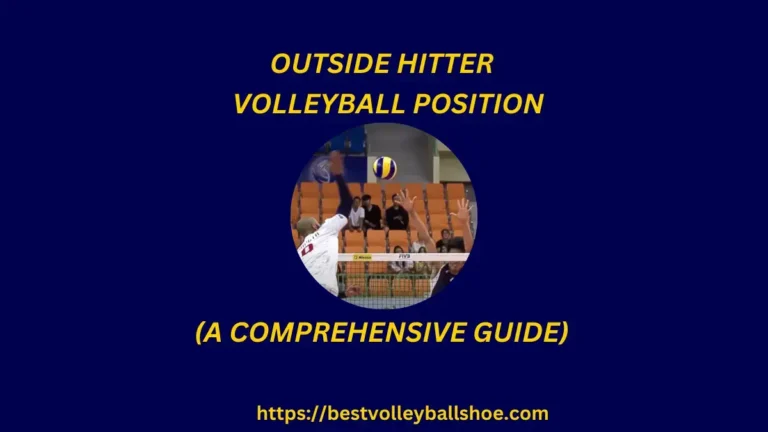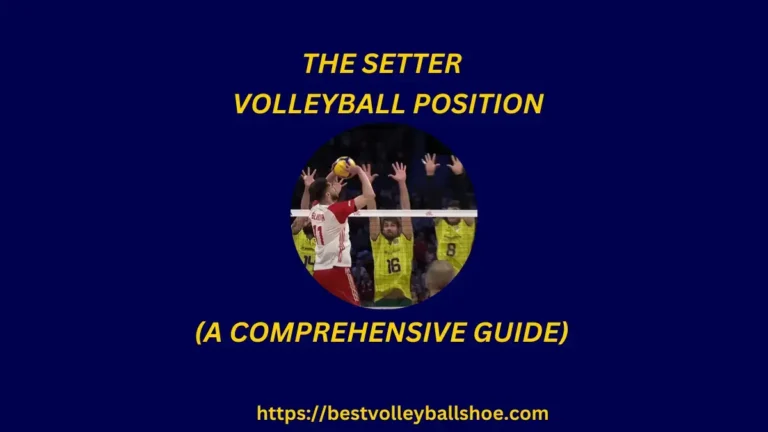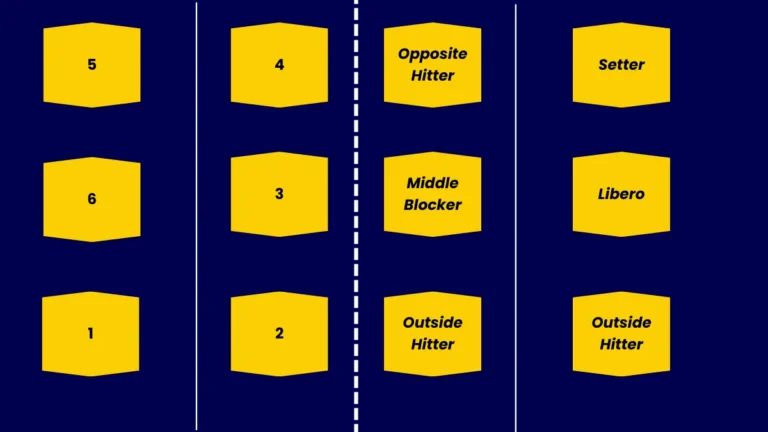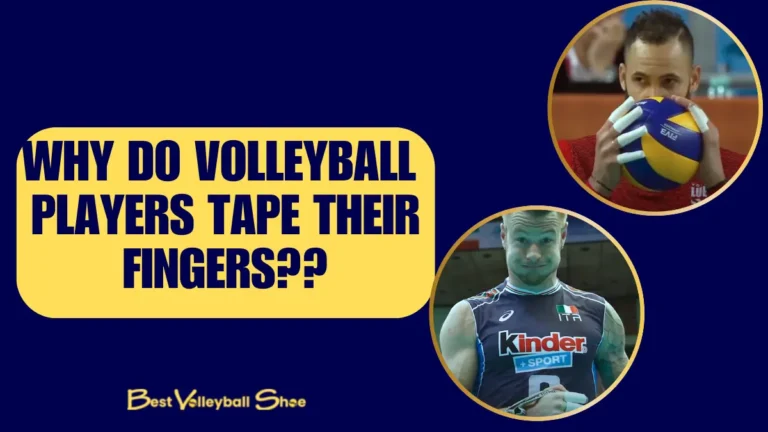Opposite Hitter Volleyball Position: A Comprehensive Guide

What is an Opposite Hitter Volleyball?
The Opposite Hitter Volleyball is a valuable and dominant spiking asset of the team. They tend to be pretty tall, but they don’t have to be the tallest. The primary job of this player is to block the opponent hitters and kill the ball.
In this article, we will discuss different basics of opposite hitter volleyball position including volleyball terms, history, volleyball rules, playing position, rotation, role, importance, qualities, physical attributes, and various equipment including Best Volleyball Shoes.
We will also enlist different gear like the best volleyball shoes and others for the opposite hitter volleyball position.
Finally, we will evaluate the recruitment standards and important tips for becoming a better opposite hitter.
So let’s dive into this!
Terms for Opposite hitters
Opposite hitter volleyball is also known as
- Spiker,
- Cannons
- Right-side hitter (RS).
Considering the various attack selections opposite hitter volleyball perform
- kill
- Tipping
- Spikes
Historical Perspective
The concept of specialized player positions, including the opposite hitter, emerged gradually with the evolution of volleyball. The introduction of distinct positions in volleyball is not attributed to a specific date, but rather to the sport’s development over time.
As the game became more organized and strategies evolved, players naturally started to take on specific roles based on their skills and positions on the court.
However, the introduction of the opposite hitter can be presumed to be included in volleyball with the inception of set and spike rules in 1916 in the Philippines.
The set and spike rule gave birth to the rule of three hits, allowing a maximum of 03 hits for returning the ball to the opponent’s court. The third hit was to be spiked by the player powerfully over the net. This is what may have given the dedicated role to the opposite hitter position over time
Volleyball Rules for Opposite Hitter
According to USA volleyball rules, an opposite hitter has to follow the following set of rules like any other volleyball player. These rules are as under:
- None of his body parts should come in contact with the net between antennas while play is in progress.
- Like any other player, they are not allowed to block the serve
- It’s also prohibited for them to go under the net, in the opponent’s court area.
- They are also prohibited from holding the ball while spiking or blocking
- He will move and rotate clockwise after every serve
- They are prohibited from touching the ball or opponent in their space during or before the attack.
- After blocking they can also pass the ball- according to rule 3 of US volleyball, contacts excluding blocks are allowed for returning the ball to the opponent. Thus, after blocking the ball into their side the opposite hitter can pass the ball.
Opposite Hitter Volleyball Rotation, Position, and Substitution of in the Court
The base position of an opposite hitter is position 02 on the front sides of the volleyball court. The opposite hitter is used in the 5-1 rotation system means there will be 05 attackers and 01 setter. The opposite hitter moves in a clockwise rotation from position 04 to position 05.
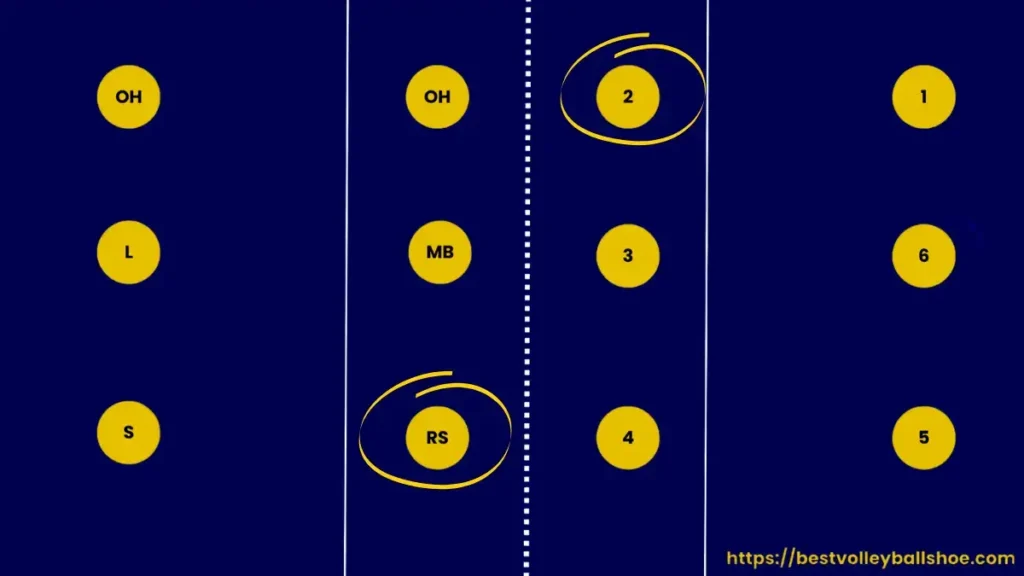
Although the main attacking position of the opposite is from positions 01 and 02. However, during the rotation he or she may have to attack from position 04.
Front row attack
During rotation in the front row opposite plays at positions 02, 03, and 04. While playing at position 02 and 04 he attacks from these positions, however, while playing at position 03 opposite moves to position 02 and attacks.
Back row attack
While playing in the back zone opposite rarely receive the serve as liberos and outside hitters primarily do this job. However, they attack from the back row of the court and infiltrate position 02.
Roles and Responsibilities of an Opposite Hitter
Right-side hitters are primarily responsible for spiking the ball from the backcourt and blocking the opponent’s outside hitters.
Playing in the front court their prime responsibility is blocking. However, while in the backcourt they are deliberately kept aside from receiving the serve or passing. The serve is received by the outside hitters and libero.
Following are the brief of their roles and responsibilities.
- Serving
- Hitting/spiking
- Blocking
- Digging
- Judging the opponent hitters
Serving
Like any other player except libero, they’re also responsible for serving. Effective serve is essential to put the opponent under pressure.
Digging
When the opposite hitter is in the backcourt, their role transforms from offensive to defensive coverage position.
This shift is crucial to anticipate potential attacks from the opposing team and contribute effectively to their team’s defense.
Although this is not their specialized role they have to dig the ball because it is the game demand from every player playing in the back side of the court.
Hitting
Opposite hitters are the scoring machines in a team. Mostly, they are there to win points and stage aggressive play. Playing on the right side of the court, they attack from the back row of the court.
You will be thinking why did opposite hitters attack from the back row of the court
The answer to this is the offensive strategy of the team where the setter is the epicenter.
The opposite hitter in the back row at position 01 means the setter at position 02 (see the picture). So, a setter playing at position 02 has plenty of options regarding setting the ball to middle blocker, outside hitter, or right-side hitter. On the other hand, he can also dump the ball.
You may see the picture below for understanding
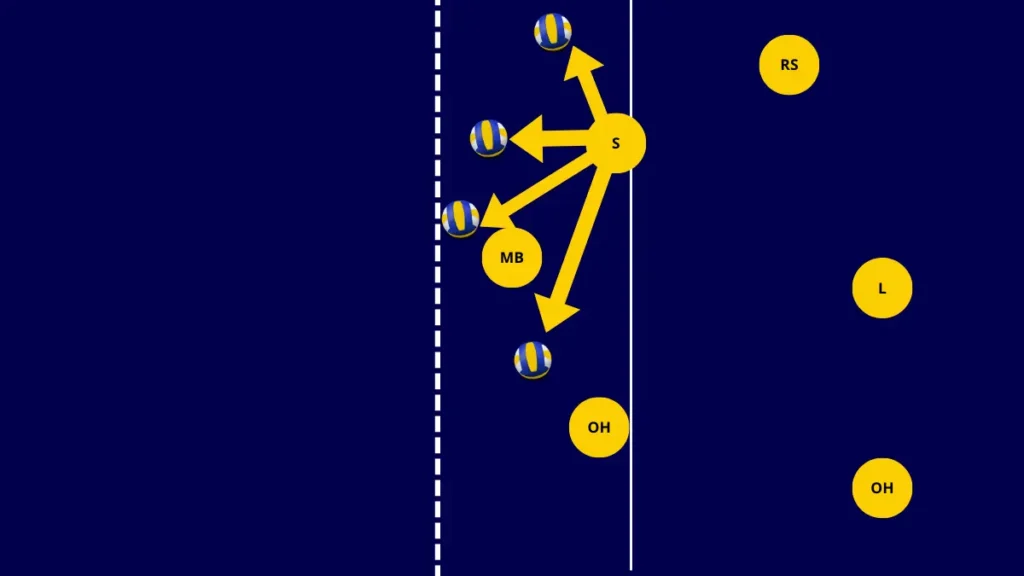
Blocking
While playing in the right front zone, the opposite hitter is primarily responsible for blocking the spikes from the outside/left-side hitter of the opposing team.
This a tough job as they have to block the left-side hitter who usually spikes from the front row.
Due to the proximity of the opponent’s left-side hitter to the net, the blockers have less time to predict and react to the spike.
Judging the Opponent Hitters
Opposite hitters often judge and inform their fellow players about the opponent hitters’ movements and attacks including tricky ones like tipping, dumping, or cutting.
Importance of an Opposite Hitter
The opposite hitter holds supporting roles to both middle blockers and outside hitters. They increase the defensive and offensive capabilities of the team.
Right sides with decent blocking skills are pertinent to stop the opponent hitters from scoring points. On the other hand, If he or she is weak at blocking the opponent hitters will become a threat to the team’s defense.
As regards the hitting, strong opposite hitters augment the offensive capabilities of the team and share the responsibilities of attacking with outside hitters.
Qualities and Strength of an Opposite Hitter
Excellent Hitting
Strong opposite hitters are best at swinging their arms and hitting the ball with power, accuracy, and versatility.
They are best at deceiving the opponent with the direction, speed, and intensity of their shots, and are masters in tipping, spiking, rolling, and pushing the ball.
Being predictable in your spikes gives a competitive edge to the opponent and chances of being blocked also increase manifold.
So outstanding opposite hitter volleyball cannot be anticipated easily by the opponent about where they plan to hit the ball. Regardless of the type of set they receive, their approach and body positioning remain consistent, making it incredibly difficult for the opposing team to judge their next move.
Excellent Blocking Skills
It is very easy to spike/serve a ball tossed in the air, but it is difficult to block that ball at the net. So blocking the ball is different from spiking.
Excellent blocking skills make great right-side hitters. They save the precious point by blocking the opponent’s outside hitter- the primary attacker of a team.
High Vertical jump
Being tall does not serve the purpose as far as this position is concerned.
Playing as opposite hitter volleyball, you should have a decent vertical jump because it’s helpful for effective blocking. This also translates into improved spiking.
Opposite hitters are not as tall as the middle blockers. But they cover this little gap with their high vertical jump.
For instance, at a professional level a verticle jump above 35” is considered decent, and Yugi Nishida who is 6′.1” tall has a vertical jump of 41.3”. So, his height is compensated by his verticle jump.
Physical Attributes of an Opposite Hitter:
Strength and Power
The opposite hitter is like a fast bowler in cricket. He should have a strong upper body and legs. A strong upper body is essential for powerful spikes from the back row of the court whereas strong legs are important for high vertical jump.
Well-Heighted
Generally, height is an important physical attribute for all volleyball positions except libero and defensive specialist. Similarly, it is a critical physical attribute for an opposite hitter.
The right-side hitter is the second-tallest player in a volleyball team after the middle hitter. The height is essential to fulfill the responsibility of the position
Heightened right-side hitters have the benefit of blocking the opponent hitters effectively- who are the primary hitters of the team.
While spiking from the back row height is important for spiking the ball from a fair height, to avoid the blockers and get a kill. This is why, the clubs at the international level prefer tall opposite hitters.
To give an idea of the average height, I have calculated the average height of the top ten opposite hitters in the world. It was 200.2 cm or 6’5.6’’ which is quite a decent number.
However, there is also an interesting thing to note Yugi Nishida was the shortest among the top ten spikers with 187 cm height.
Endurance
To meet the game requirement and achieve the highest performance.
Hand-eye coordination
For a quick reaction after judging the tricky balls like tipping, dumping, or cutting.
Fortitude
To handle the pressure situation and maintain consistency
Recruitment Standards for Opposite Hitter Volleyball at Collegiate
I have briefly described various introductory aspects of the opposite hitter volleyball position including introduction, history, rules, role and responsibilities, qualities, and physical attributes.
The abovementioned information mostly covers the basics and is generic for all readers. However, from this section, I am addressing those who are looking for a career or who have plenty of experience as a volleyball player. Here are the various guidelines for the recruitment of an opposite hitter at the college level in the USA.
According to the NCSA, the recruitment standards for the women opposite hitters are given below mentioned graph. The prime factors for recruitment include
- Height,
- Standing Reach,
- Attack jump,
- Block Jump,
- Vertical Jump,
- Experience.
Recruitment guidelines for Women:
As per guidelines, the average height for opposite hitters at the college level in the USA is 155.448 cm, standing to reach 240.8cm, attack jump and block jump 283.4, and verticle jump 624.8 cm.
As regards the experience, a woman opposite hitter should have open-level and national-level playing club experience. This is to gauge the knowledge of the game and position.

Recruitment guidelines for Men:
The recruitment guidelines for men’s opposite hitter volleyball aren’t formally available like women. However, the few stats data that are available include height and approach jump. The stats are as under:
Height
Depending on various playing levels and divisions of NCSA the average height for a volleyball player is between 6’2’’’ to 6’8’’. This data shows that the opposite hitters are the second-tallest volleyball players.
Approach Jump
The average approach jump for an opposite hitter is 10’11’’.
Should I be an Opposite Hitter?
I would like to break down the answer into two segments
Firstly, do you meet the required physical standards the most important among them is height.
For clarity, I will mention the average height calculated from the top ten opposite hitters in the world. It is 200.2 cm or 6’5.6’’ which is quite a significant number and excludes more than 95% of the population.
However, there is also an opportunity that Yugi Nishida is the shortest among the top ten spikers with 187 cm or 6’.1’’ in height.
So, in my opinion, if you are a shorter athlete then this position is not for you, except you have a very high vertical to fill the space of your height. Even then you have to compete with the tall players while getting selected.
Secondly, after fulfilling the height criteria, are you interested in this playing position? If yes then you should go for it.
Is the Opposite hitter an excellent position to play in volleyball?
I will rate this position as the best position to play in volleyball. The reason for this position is because of the less responsibility of passing.
As stated earlier while passing they are mostly covered by the other players. However, you also have to face challenges while spiking from the back row and blocking in the front row.
Spiking from the right side can be more challenging for a few players. On the other hand, if you are a lefty and meet the physical standards and vertical jump then surely this position is for you.
I would also like to list down a few other aspects of this position. Firstly, right-side hitters are among the popular players on the volleyball court because of their powerful spikes e.g. Yugi Nishida.
At the professional level, it also has a great scope because the clubs prefer to hire a strong and tall foreign hitter. So, being a tall hitter with good playing skills you have a great career opportunity.
How to be a better Opposite hitter
Improve your Vertical jump
As I have mentioned earlier and also evident from the recruiting guidelines, an opposite hitter should have a decent vertical jump. So I will advise you to spend more time in the gym polishing your jumping skills.
Improve your blocking skill
(Video)
Practice Backrow hitting
As a right-side hitter, you have to spike from the back row which is not an easy job.
The only way to bring your back row spiking to perfection is through practice and repetition. The more you practice more the perfection you get.
Thus, ask your setter to set more on the back row while practicing.
Master the Jump Serve
Have you seen Yugi Nishida serving the ball? He serves like he is spiking the ball from the end of the court. To me, this could be one of the reasons for his being so successful opposite hitter.
Mastering jump serve will also be helpful in improving the spike from the backcourt. If you deliver a powerful serve for the end of the court farther from the net, you will definitely be in a position to spike more strongly and hardly near the net.
Hence, practicing one thing will also improve the other
Critically Watch videos of the best opposite hitters
It is agreed that highly qualified coaches and staff train world-class players. Critically watching their videos can be a practical demonstration of their learning from their coaches.
So, it can be incredibly beneficial for your development as a right-side hitter. These videos can help you better:
Understanding your mistakes
It is pertinent to train and work on your mistakes after watching the videos. Otherwise, you won’t be able to get more than enjoyment like a spectator
Volleyball gears for an opposite hitter
Volleyball Shoes
Knee Pads Photo
Training Equipment for Opposite Hitter
Here are a few training equipments for the opposite hitter.
Key Performance Indicator of a Hitter
Attack Points
- Attack points are points that a team earns when they successfully execute an offensive play, usually by spiking the ball into the opponent’s court and making it land in the opponent’s court.
- To earn an attack point, the attacking team must overcome the opponent’s defense by hitting the ball past or through the blockers and into the court.
- Attack points are a fundamental way of scoring in volleyball and are often the result of coordinated plays between setters and hitters.
- Total Kills The number of successful attacks that result in a point for the team.
- Hitting Percentage This measures the percentage of successful attacks (kills) relative to the total number of attempts. A high hitting percentage indicates efficiency in scoring points.
Block Points
- Block points are points that a team earns when they successfully block an opponent’s attack at the net, causing the ball to either land out of bounds on the opponent’s side or to be blocked directly back into the opponent’s court.
- Blocking is a defensive technique where players try to intercept and redirect the opponent’s attack at the net.
- When a team’s blockers are effective in preventing the opponent from scoring with their attacks, they earn block points.
- Blocks: The number of successful blocks made at the net, helping to stop the opponent’s attacks.
- Blocking Percentage: It is the percentage of successful blocks relative to the total number of block attempts, showcasing a hitter’s ability to read the opponent’s attacks and contribute to defense.
Serve Points
- Serve points are points that a team earns when they win a rally directly from their serve. This can happen in a few ways:
- Ace: A serve that lands in the opponent’s court and cannot be successfully returned, resulting in an immediate point for the serving team.
- Service Error: When the serving team’s serve results in a fault, such as hitting the net or landing out of bounds, the receiving team earns a point.
- Passive Reception: Sometimes, a serve can disrupt the opponent’s reception, leading to a poorly executed play and an easier opportunity for the serving team to score.
Opposite Hitter Volleyball FAQs
How many opposite hitters are there in a team?
Usually, a team has two opposite hitters. One plays in the court whereas the second is the replacement.
Are the Opposite hitter and Outside hitter the same?
The basic difference between both hitters is their playing position. The outside hitter attacks from the left side of the court and is also known as the left-side hitter whereas the opposite hitter spikes from the right side and is known as the right-side hitter.
Should i play as opposite hitter or outside hitter?
Firstly, do you meet the required physical standards the most important among them is height. If yes! then you are eligible for the opposite hitter volleyball position. Secondly, if you want to be a spiker with less responsibility then you should play as the opposite instead of an outside hitter.
